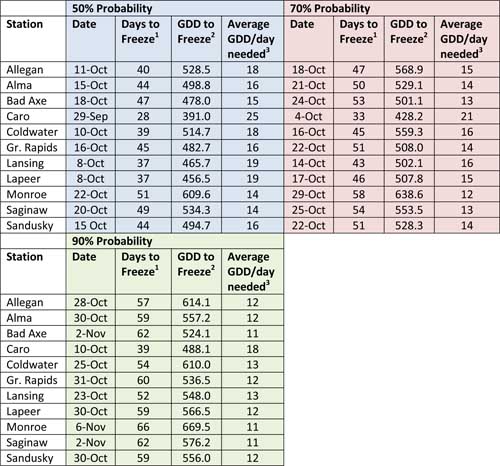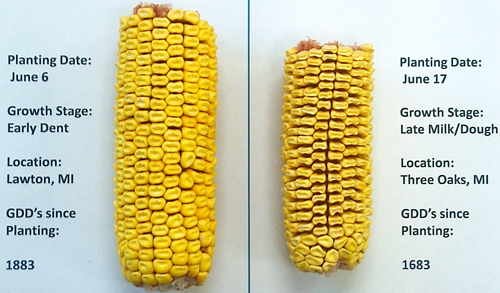Assessing the probability of Michigan’s corn crop reaching physiological maturity
Knowing what late planted corn requires and tracking crop progress can help growers make decisions on how their crop can best be utilized.
Corn planted in June, drought conditions in July, and variable amounts of rain in August all have an impact on corn development. Given this, what did Michigan’s late planted corn look like on September 1?
Late planted corn from Mount Pleasant to the Thumb, from southeast Michigan to Berrien County was in the milk (planted June 5 – 17), dough (planted June 1 – 5) and mid-dent (planted late May) stage on September 1. The question, then, is will the corn make it? The answer – it depends!
Corn development from now until harvest will be impacted by temperature, precipitation and, of course, when we get the first killing freeze. Although we won’t give predictions for rainfall, we can provide some history on the first killing freeze and Growing Degree Day (GDD) accumulations. This will help to determine the likelihood of late planted corn maturing.
Table 1 provides dates of first killing freeze by location (data was from 1961 – 1990). Each category indicates the date at which 50, 70 or 90 percent of the time the freeze occurred on or before that day. For example, if you are in Allegan, there is a 50 percent probability that you will get a killing freeze by October 11, and a 90 percent chance you will get the freeze by October 28.
Table 1. Probability corn will reach physiological maturity

1 Calculated from September 1 to probable freeze date.
2 Growing Degree Days (GDD) 5-year average (2006-2010) from Enviro-weather.
3 Based on 700 GDD needed to reach physiological maturity.
(MSUE Bulletin E-2471, Using Climatological Information for Corn Hybrid Selection, March 1994
Statistics for date of first killing freeze (defined as minimum temperature of 30 degrees F or below) in the
fall for the period 1961-1990. )
The number of days from September 1 to freeze, the GDD average to maturity and the number of GDDs needed per day from September 1 to freeze are also provided for each location. The GDD are based on Enviro-weather data 2006 – 2010.
Much of the late planted corn is in the milk or dough stage. Table 2 indicates corn in this stage will take 30-35 days and 650 – 750 GDD to reach maturity. Just looking at days to reach physiological maturity, the corn should mature by the first killing freeze. However, GDD is the real indicator of how quickly the corn matures and that is dependent on temperature. GDD were accumulating rapidly prior to Labor Day (September 5), but this week it has slowed. So, if we have a warm fall, and a late frost, most locations have the potential to have corn mature.
Table 2. Relationship between kernel growth state and development
| Stage | Calendar days to maturity (average) | GDD to maturity | % of max. yield grain | % of max. yield whole plant | Moisture content % grain | Moisture content % whole plant |
| Silk | 50-55 | 1100-1200 | 0 | 50-55 | --- | 80-85 |
| Blister | 40-45 | 875-975 | 0-10 | 55-60 | --- | 80-85 |
| Late milk dough | 30-35 | 650-750 | 30-50 | 65-75 | 85-95 | 80-85 |
| Early dent | 20-25 | 425-525 | 60-75 | 75-85 | 50-55 | 70-75 |
| Fully dented1 | 10-15 | 200-300 | 90-95 | 100 | 35-40 | 65-70 |
| Physiological maturity2 | 0 | 0 | 100 | 95-100 | 25-35 | 55-65 |
1 Kernel milk-line moved 0.5 to 0.75 the distance between crown & base.
2 Black layer formation and milk disappearance from kernel under normal development.
(Adapted from Kernel Development: Will Corn Mature Before harvest? What will happen if it doesn’t? Paul Carter, Wisconsin Pest Manager, Vol. 15, No. 19, 1992.)
However, there is no guarantee we will have a warm fall and a late freeze. So, what happens when corn dies before it matures? Former University of Purdue grain storage specialist and current Kansas State University specialist Dirk Maier said in a 1996 article, “Drying Frost-damaged Corn” that it really depends upon what stage the corn was in when the frost occurred.
Late dough stages
Yields will be low, test weights will likely be in the 40s and harvest moistures may be near 60 percent. Corn damaged by frost at this stage will eventually field dry to around 35 percent moisture, but the length of time that it would have to remain in the field depends upon heat, rainfall, humidity and wind.
Ear molds can set in if warm moist conditions follow an early frost. Also, kernels from late dough stage corn can turn brown if dried at normal temperatures in a forced air dryer. The kernels can be dried with maximum kernel temperatures reaching around 120-140 degrees (very low heat, drier plenum temperatures of 140-160 degrees). Maier also suggested that transferring the corn hot to an in-bin drier with a stir-rator can help speed up the drying process. This corn should be stored below 14 percent moisture and only stored for sale or use by spring.
Full dent stage
Yields will be somewhat lower and moisture level will be around 50 to 55 percent. Dry and store corn similarly to that harvested in the late dough stage (listed above). Feed quality for grain harvested at test weights more than 50 should be similar to corn harvested at physiological maturity. Corn harvested below 50 will have more feed quality issues.
Late dent stage
Yields will be off 5 to 10 percent and test weights should be near normal. Corn moisture will be around 40 percent. Producers should hold crop in field until moisture levels drop to around 30 to 35 percent if possible.
(Adapted from Drying Frost Damaged Corn; Dirk Maier, Ag Answers, Ohio State and Purdue University Extension Partnership, published on the web on October 11, 1996.)

Kernel shrink demonstrating the impact of the cessation of dry matter accumulation for
two ears picked and dried at the early dent and the late milk-early dough stage of development
on September 1, 2011.
If an early frost is likely to occur, farmers may want to look at alternative markets. Silage or high moisture grains may be an alternative market. Lining up buyers early in the season may provide a market for grain that is at greater risk of not making it to maturity. See the MSU Extension News for Agriculture article, “Guidelines for pricing corn silage and earlage from immature corn,” for information on pricing these feeds.
Will Michigan’s late planted corn make it? The answer is still “it depends.” Knowing what it depends on and tracking crop progress can help make decisions on how the crop can best be utilized.
Related article:
- "Will your corn reach maturity?" MSU Extension
Read other articles related to late planting and high feed costs.



 Print
Print Email
Email



